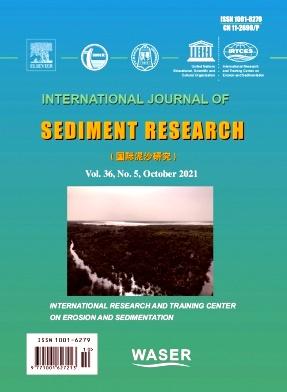Evaluating critical hydrodynamic characteristics of rill formation on saturated soil slopes
IF 3.7
2区 环境科学与生态学
Q2 ENVIRONMENTAL SCIENCES
引用次数: 0
Abstract
As a specific near surface hydrological condition, soil saturation can significantly affect the critical hydrodynamic characteristic and soil erosion rate of rill formation, leading to severe rill erosion. Nevertheless, few studies have investigated the characteristics of critical hydrodynamic parameters and their relationships with rill erosion rate under critical hydrodynamic conditions of rill formation on saturated soil slopes. Consequently, the quantification of critical hydrodynamic parameters and their effects on rill erosion rate under critical hydrodynamic conditions of rill formation on saturated soil slopes is of great significance for understanding the dynamic mechanism of rill formation and evolution and for predicting and controlling soil loss. In this study, indoor simulated rainfall experiments were performed and a new analytical model (Vc(NAM)) was applied to calculate the aforementioned critical parameters under a wide range of hydraulic conditions comprising five slope gradients (SG) (2°, 5°, 10°, 15°, and 20°) and three rainfall intensities (RI) (30, 60, and 90 mm/h). The results indicated that the new analytical model (Vc(NAM)) was suitable for estimating critical hydrodynamic parameters on saturated soil slopes. The critical flow velocity (Vc), the critical shear stress (τc), and the critical stream power (ωc) apparently increased, whereas the critical rill length (Lc) decreased with the increase of slope gradients and rainfall intensities. Moreover, the erosion rate at the critical condition increased with decreasing Lc and increasing Vc, τc, and ωc. Pearson correlation analysis indicated that τc and ωc were significantly positively correlated, whereas Lc was negatively correlated with erosion rate under the critical conditions. Stepwise regression analysis revealed that the erosion rate under critical hydrodynamic conditions of rill formation could be well predicted by τc (R2 = 0.83) with the linear model. The results provide an accurate model for evaluating critical conditions of rill formation and a basis for further understanding the intrinsic dynamic mechanism of rill formation on saturated soil slopes.
饱和土质斜坡上细沟形成的临界水动力特性评价
土壤饱和作为一种特定的近地表水文条件,会显著影响细沟形成的临界水动力特性和土壤侵蚀速率,导致严重的细沟侵蚀。然而,对于饱和土坡面成沟临界水动力条件下的临界水动力参数特征及其与细沟侵蚀速率的关系研究较少。因此,在饱和土坡面形成细沟的临界水动力条件下,定量研究临界水动力参数及其对细沟侵蚀速率的影响,对于认识细沟形成和演化的动力机制,预测和控制土壤流失具有重要意义。在本研究中,进行了室内模拟降雨实验,并应用了一种新的分析模型(Vc(NAM))来计算上述关键参数,该模型包括5种坡度(SG)(2°、5°、10°、15°和20°)和3种降雨强度(RI)(30、60和90 mm/h)。结果表明,该分析模型(Vc(NAM))适用于饱和土质边坡临界水动力参数的估计。随着坡度和降雨强度的增加,临界流速(Vc)、临界剪应力(τc)和临界水流功率(ωc)明显增大,而临界细沟长度(Lc)减小。临界侵蚀速率随Lc的减小和Vc、τc、ωc的增大而增大。Pearson相关分析表明,临界条件下τc和ωc与侵蚀速率呈显著正相关,Lc与侵蚀速率呈显著负相关。逐步回归分析表明,利用线性模型τc (R2 = 0.83)可以较好地预测细沟地层临界水动力条件下的侵蚀速率。研究结果为评价饱和土边坡上细沟形成的临界条件提供了准确的模型,为进一步认识饱和土边坡上细沟形成的内在动力机制奠定了基础。
本文章由计算机程序翻译,如有差异,请以英文原文为准。
求助全文
约1分钟内获得全文
求助全文
来源期刊
CiteScore
6.90
自引率
5.60%
发文量
88
审稿时长
74 days
期刊介绍:
International Journal of Sediment Research, the Official Journal of The International Research and Training Center on Erosion and Sedimentation and The World Association for Sedimentation and Erosion Research, publishes scientific and technical papers on all aspects of erosion and sedimentation interpreted in its widest sense.
The subject matter is to include not only the mechanics of sediment transport and fluvial processes, but also what is related to geography, geomorphology, soil erosion, watershed management, sedimentology, environmental and ecological impacts of sedimentation, social and economical effects of sedimentation and its assessment, etc. Special attention is paid to engineering problems related to sedimentation and erosion.

 求助内容:
求助内容: 应助结果提醒方式:
应助结果提醒方式:


